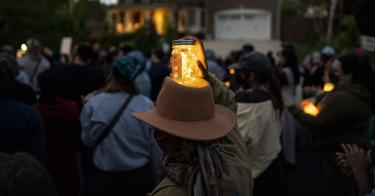“Here, sir, the people govern,” Alexander Hamilton said when explaining the republican form of government recently established in America. “Here, they act by their immediate representatives.” Most Americans agree, at least in theory, but theory is easy. It’s in practice, when this system does not deliver everything you want, that Americans really take sides.
That test is now before us. In 1973, the Supreme Court took authority to regulate abortion away from those “immediate representatives,” imposing a national policy of virtually unrestricted abortion that most Americans have never supported. The possibility that the court will put the people and their representatives back in charge is quickly exposing who respects their fellow citizens and who just wants the power to control them.
America’s founders wrote the Constitution down, the Supreme Court explained in Marbury v. Madison, so that its rules for government “may not be mistaken or forgotten.” Thomas Jefferson warned that if the Supreme Court controlled the Constitution’s meaning, it would be “a mere thing of wax” that the justices “may twist and shape into any form they please.”
The court has never twisted and shaped more aggressively than it did in Roe v. Wade. It invented a “right” to almost unrestricted abortion and erased the abortion laws passed by the people’s immediate representatives in all 50 states.
>>> Correcting a Grave Constitutional Error
The Supreme Court said that the Constitution had something to do with its decision, but only because it had to say so. In fact, Justice Harry Blackmun’s majority opinion did not even attempt to interpret the 14th Amendment, where the right to abortion supposedly resides.
Instead, Roe rests on a foundation of pure policy. In the very next sentence (p.159 of the opinion), after announcing that the right to abortion exists, Blackmun described the “detriment” that banning abortion would impose.
That’s it. So let it be written, so let it be done. That’s a very powerful gig, if you can get it. Being able, as Justice George Sutherland warned in 1937, to amend the Constitution “in the guise of interpretation” turns the justices’ oath of office into a pledge to support and defend themselves.
Again, this sounds good in theory. But watch what is unfolding before our eyes today and the lengths to which abortion advocates are going to keep their ill-gotten judicial gains. For years, they have turned Supreme Court nominations into gladiatorial combat. Now they want to destroy the Supreme Court’s independence through court-packing, and they intend to blow up the Senate by eliminating its practice of unlimited debate.
Even Roe v. Wade, in all its policy-driven extremism, is no longer enough to sate today’s abortion champions. They are pushing the misnamed Women’s Health Protection Act, which would prohibit any government anywhere in America, down to the smallest village or hamlet, from doing anything that might make the actual performance of abortions the slightest bit less likely.
This has nothing to do with Congress attaching conditions to money that it gives to the states. Nor is it Congress preempting state or local regulation by enacting its own. The Constitution does not protect any right to abortion, and Congress has no authority to create one that would limit state and local government.
>>> Democrats Push Radical Abortion Bill Far More Expansive Than Roe
As difficult as it is for abortion extremists to accept, state and local government had authority to set abortion policy before Roe v. Wade, and they will have such authority after it is overruled. That neither guarantees a particular outcome nor shuts certain voices out of the process.
Admitting that Roe v. Wade was a mistake, that abortion regulation should never have been taken away from the American people, will not by itself make abortion illegal. Unless the Constitution clearly says otherwise, however, the people “act through their immediate representatives,” wrestling with difficult issues, working out compromises, and then using elections to reset the political chessboard. In that system, liberty is more important than power.
At the convention that drafted the Constitution in 1787, someone is said to have asked Benjamin Franklin what form of government the delegates had established. “A republic,” he said, “if you can keep it.” Keeping it requires a commitment to stick with it—even when you don’t win every time.
This piece originally appeared in The Sacramento Bee




